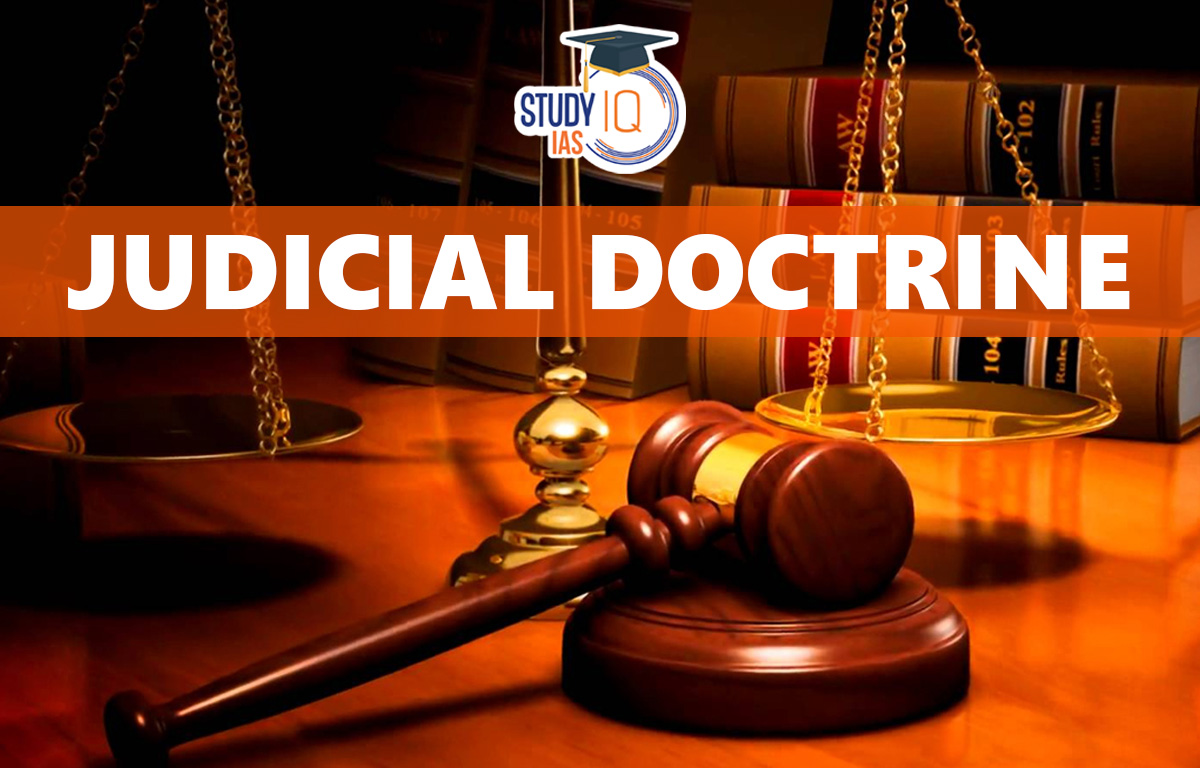Table of Contents
Judicial Doctrines
A doctrine is a principle or belief often held by authorities like courts. It can be a rule or a legal theory. In India, there are several important judicial doctrines under the Constitution.
This doctrine states that the fundamental structure of the Indian Constitution cannot be changed, even by a constitutional amendment. This means Parliament cannot make laws that alter the Constitution’s basic structure. Although it is not explicitly mentioned in the Constitution, it has developed through various Supreme Court rulings.
Read More: Fundamental Rights of Indian Constitution
List of Judicial Doctrines in Indian Constitution
Here is the complete List of Doctrines in the Constitution of India provided below:
| The doctrine of Pith and substance |
Pith and Substance means looking at the true nature and essential part of a law. This doctrine was first recognized in the Canadian Constitution and was adopted in India during the pre-independence period under the Government of India Act, 1935.
Applicability:The Doctrine of Pith and Substance is used to determine if a law relates to a specific subject listed in the Seventh Schedule. Courts examine the true nature of the law in these cases. It also applies when there are conflicts between laws made by Parliament and those made by State Legislatures, helping to resolve inconsistencies. Important Judgment:In Prafulla v. Bank of Commerce (1946), the Supreme Court ruled that a State law on money lending is valid even if it affects promissory notes incidentally. |
| Doctrine of Colourable Legislation |
The Doctrine of Colourable Legislation, also known as “Fraud on the Constitution,” applies when a legislature lacks the authority to create a law on a specific subject but tries to do so indirectly. This principle helps determine whether the legislation in question is valid. It comes from a Latin maxim meaning that if a legislature cannot do something directly, it cannot do it indirectly.
Constitutional Provision:This doctrine is often applied to Article 246, which outlines the legislative powers of Parliament and State Legislatures, covering different subjects in the Union, State, and Concurrent lists. Limitation:The doctrine doesn’t apply if a legislature has no constitutional restrictions on its powers. It also doesn’t apply to subordinate legislation. Important Judgment:In R.S. Joshi v. Ajit Mills (1977), the Supreme Court stated that if a legislature tries to make a law it isn’t allowed to, even if it appears competent, it is considered colourable legislation. |
| Doctrine of Delegated Legislation |
| Executive authority is granted powers by primary legislation to create laws or similar rules. In the case D.S. Gerewal v. State of Punjab (1959), the court used this doctrine to confirm that the All India Service Act of 1951 was constitutional. It stated that Article 312 of the Indian Constitution does not restrict the power to delegate authority. |
| Doctrine of Necessity |
| This doctrine is used to justify the state’s violation of rights or actions outside the Constitution in extreme situations to restore peace and stability. In Gullapalli Nageshwar Rao vs. State of Andhra Pradesh, the court ruled that this doctrine should only be applied in exceptional cases. |
| Doctrine of Pleasure |
The doctrine of pleasure comes from English law, where a civil servant serves at the pleasure of the Crown.
Constitutional Provisions:Article 155: The Governor of a State is appointed by the President and serves at the President’s pleasure. Limitation:Article 311: This article limits the doctrine by protecting civil servants from arbitrary dismissal. Important Judgments:In State of Bihar v. Abdul Majid (1954), the Supreme Court ruled that not all English Common Law was fully adopted in India. |
| Doctrine of Eclipse |
The Doctrine of Eclipse is applied when a law violates Fundamental Rights (FR). In this case, the FR takes precedence, making the law unenforceable, but not completely void. The law can be enforced again if the restrictions on Fundamental Rights are removed. This doctrine only affects citizens; the law remains applicable to non-citizens who do not have Fundamental Rights.
Constitutional Provisions:The Doctrine of Eclipse is mentioned in Article 13(1) of the Indian Constitution and does not apply to laws made after the Constitution was adopted. Important Judgment:The doctrine was first introduced in Bhikaji Narain Dhakras v. State of Madhya Pradesh (1955). The Supreme Court ruled that a law allowing the Provincial Government to control motor transport violated Article 19(1)(g) and became temporarily eclipsed by the Fundamental Right. |
| Doctrine of Severability |
The Doctrine of Severability, also known as the doctrine of separability, protects citizens’ Fundamental Rights. According to Article 13(1) of the Constitution, if any law conflicts with Fundamental Rights, that part of the law is void, but the rest remains valid. This doctrine originated in England from the case Nordenfelt v. Maxim Nordenfelt Guns and Ammunition Company Ltd., which involved a trade clause.
Limitation:If the valid and invalid parts of a law are too closely connected to separate, then the entire law may be declared invalid. Important Judgments:In A.K. Gopalan v. State of Madras (1950), the Supreme Court ruled that only the conflicting part of a law is void, not the whole law, and efforts should be made to preserve as much of the law as possible. |
| Doctrine of Territorial Nexus |
The doctrine states that laws made by a State Legislature apply only within that state unless there is a clear connection between the state and the subject of the law.
Constitutional Provisions:This doctrine is based on Article 245 of the Indian Constitution. Article 245(2) says that no law made by Parliament can be declared invalid just because it applies outside India. Important Judgments:In A.H. Wadia v. Income Tax Commissioner (1948), the court ruled that the issue of a law’s extraterritoriality cannot challenge its validity. |
| The doctrine of Implied Powers |
| Implied powers are those not explicitly given by the Constitution to authorities like Parliament or the Supreme Court, but are assumed to be necessary for fulfilling their responsibilities. In the case Bidi Leaves and Tobacco Merchant’s Association v. The State of Bombay, the Supreme Court discussed the Doctrine of Implied Powers, stating it can only be used if enforcing the law would be impossible without those powers. |
| Doctrine of Incidental or Ancillary Powers |
The Doctrine of Incidental or Ancillary Powers is an extension of the Doctrine of Pith and Substance. It is used when there is a need to support the main legislation by allowing laws related to the subject matter. This doctrine originates from the English Court of Appeal case R. v. Waterfield (1963).
Constitutional Provisions:Article 4: Allows for changes in laws related to altering state names under Articles 2 and 3. Important Judgment:In State of Rajasthan v. G. Chawla (1958), the Supreme Court stated that the power to legislate on a main topic also includes the power to legislate on related matters that are reasonably connected. |
| Doctrine of Precedent |
| Article 141 of the Indian Constitution establishes that the Supreme Court’s laws and decisions are binding on all courts in India. In the case Mohd. Ahmed Khan v. Shah Bano Begum, the court ruled that the Supreme Court’s interpretation of religious texts is a binding precedent. |
| Doctrine of Harmonious Construction |
Harmonious Construction is a way of interpreting laws that ensures all provisions of a law work together without conflict. When a law has multiple meanings, it should be interpreted so that each meaning is effective and none are ignored. The Doctrine of Harmonious Construction developed through various court interpretations, starting with the landmark case Shankari Prasad v. Union of India.
Principles:In the case CIT v. Hindustan Bulk Carriers (2003), the Supreme Court outlined five key principles of this doctrine:
Important Judgments:In the Re-Kerala Education Bill 1951 case, the court stated that when considering fundamental rights, it must also take into account directive principles, balancing both. |


 Admiralty (Jurisdiction and Settlement o...
Admiralty (Jurisdiction and Settlement o...
 Enemy Property Act in India, Background ...
Enemy Property Act in India, Background ...
 Phone-tapping in India, Legal Framework ...
Phone-tapping in India, Legal Framework ...





















